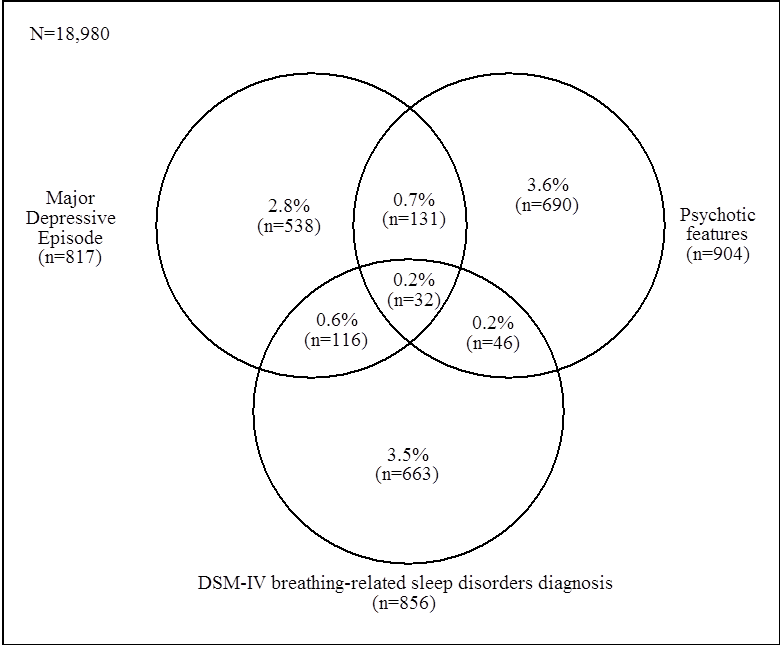Narcolepsy Diagnosis: Comparison between the Sleep-EVAL System and Clinicians
First created | 01/12/1994
Last edited |
- Ohayon MM, Guilleminault C, Paiva T, Priest RG, Rapoport DM, Sagales T, Smirne S, Zulley J. An international study on sleep disorders in the general population: methodological aspects of the use of the Sleep-EVAL system. Sleep 1997;20:1086-92.
- Ohayon MM, Guilleminault C, Zulley J, Palombini L, Raab H. Validation of the Sleep-EVAL system against clinical assessments of sleep disorders and polysomnographic data. Sleep 1999; 22:925-30.
- Ohayon MM, Okun ML. Occurrence of sleep disorders in the families of narcoleptic patients. Neurology. 2006;67:703-705.
- Ohayon MM. Sleep-EVAL, Knowledge base system for the diagnosis of sleep disorders. Registration #437699, Copyright Office, Ottawa: Industry Canada, Canadian Intellectual Property Office. 1994
This study aimed:
- to compare the diagnoses of the Sleep-EVAL System with those of 3 sleep specialists using the same sample of subjects;
- to establish the abilities of the Sleep-EVAL System to discriminate and
- to evaluate correctly narcoleptic subjects inside an heterogeneous sample of individuals.
Narcolepsy is a disabling sleep disorder characterized by recurrent daytime naps or lapses into sleep occurring almost daily. This disorder affects about 40 individuals per 100,000.
METHODS
SAMPLE
Sleep-EVAL System (Ohayon, 1994; CIPO #437699) was administered by telephone interviews to narcoleptics and their family (father, mother brother/sister) and also to control subjects.
Out of 518 subjects participating to a survey on narcolepsy, 90 subjects were randomly selected.
GOLD STANDARDS
For the narcoleptics: the diagnosis established at the Sleep Disorders Center based upon clinical, polysomnographic and genetic tests.
For the family members and the control subjects: diagnostic agreement between at least 2 on 3 sleep specialists.
Clinical observations were reviewed by three sleep specialists who highlighted the main symptoms underlying each of their three diagnoses.
Each observation consisted of
- sociodemographic information;
- medical history (consultations, medications, hospitalizations, physical diseases);
- sleep/wake schedule;
- sleep hygiene;
- sleep symptoms;
- daytime sleepiness;
- cataplexy;
- hypnagogic/hypnopompic hallucinations and other types of hallucinations;
- sleep paralysis;
- psychiatric symptomatology.
A diagnostic consensus was established when two of the three specialists gave the same diagnosis. This diagnostic consensus was then compared to that provided by the Sleep-EVAL system (Ohayon M. Knowledge Based System Eval Decisional Trees and Questionnaires. Ottawa: National Library of Canada, ISBN 2-921483-06-8, 1995).
RESULTS
The sample was composed of:
- 14 narcoleptics: mean age: 25.6 (±4.3) yrs; 9 were women
- 17 fathers of narcoleptics: mean age: 54.3 (±5.6) years
- 18 mothers of narcoleptics: mean age: 51.6 (±6.0) years
- 19 sisters of narcoleptics: mean age: 28.6 (±6.8) years
- 11 brothers of narcoleptics: mean age: 24.8 (±8.0) years
- 11 controls: mean age: 28.0 (±10.1) years; 6 were women
18 subjects were diagnosed with narcolepsy by the Sleep-EVAL System and the Sleep Specialists.
- 14 of these 18 subjects were narcoleptic individuals (previously confirmed with clinical exams, PSG, MSLT, blood tests).
- 4 new narcolepsy cases were identified in the families by the Sleep-EVAL System and the Sleep Specialists.
AGREEMENT ON NEW CASES OF NARCOLEPSY

AGREEMENT ON SLEEP AND MENTAL DISORDERS

AGREEMENT ON NARCOLEPSY
Nearly perfect agreements were observed between the three sleep specialists on the diagnosis of narcolepsy.
Kappas between the Sleep-EVALSystem and each of the sleep specialist were high.
A perfect agreement was obtained with the sleep specialist #3.
On two cases, the Sleep-EVAL System and two sleep specialists diagnosed a narcolepsy while one sleep specialist concluded to the absence of narcolepsy.
For one case, the Sleep-EVAL system and one sleep specialist concluded to the absence of narcolepsy and two sleep specialists concluded narcolepsy was present.
OVERALL AGREEMENT
Between the Sleep-EVAL System and the three sleep specialists on the narcolepsy diagnosis was: Kappa: 0.97; Sensitivity: 94.7%; Specificity: 100%
CONCLUSIONS
The results show it is possible to reliably identify narcoleptic individuals based on self-report information during a telephone interview with the Sleep-EVAL System.
This is confirmed by:
- a high agreement when the Sleep-EVAL System narcolepsy diagnosis is compared to the sleep specialist's diagnosis using the results of exams (PSG, MSLT, blood tests)
- a high agreement between the Sleep-EVAL System and the three sleep specialists NOT using the results of laboratory exams.
Moreover, the study allowed to identify 4 new narcolepsy cases among the family members and control subjects.
